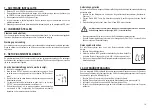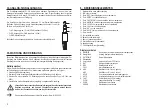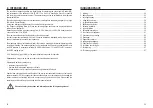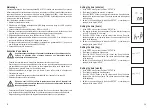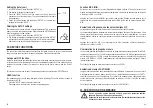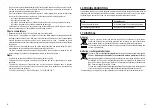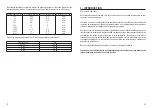
45
Régler la date (année)
Appuyez 5 x sur la touche « SETUP » dans le menu SETUP.
1.
L’écran pour régler l’année s´af
fi
che.
2.
Appuyez sur la touche « LEVEL » pour régler l’année actuelle. Maintenez
3.
la touche enfoncée pour con
fi
gurer rapidement la valeur. Pour le réglage,
les chiffres dé
fi
lent uniquement dans l’ordre croissant et recommence à
la
fi
n avec le premier chiffre.
Passez avec la touche « SETUP » à l’étape de réglage suivante ou
4.
terminez le paramétrage avec la touche « HOLD ».
Effacer les réglages SETUP
La dernière option permet d´effacer tous les paramètres prédé
fi
nis. Cette
opération peut être nécessaire lorsque la pile a été remplacée. Effacez
toujours les fonctions SETUP avant de procéder à un nouveau réglage.
Appuyez 6 x sur la touche « SETUP » dans le menu SETUP.
1.
L´écran pour effacer les réglages apparaît. Appuyez sur la touche «
2.
SETUP » pour accéder à la première option de réglage ou sur la touche
« HOLD » pour effacer les réglages. Après leur effacement, le système
commute automatiquement en mode de mesure.
FONCTIONS DE L’APPAREIL
10.
Le sonomètre possède différentes fonctions supplémentaires facilitant les mesures et la manipulation,
et permettant d’élargir le domaine d’application. Ces fonctions supplémentaires sont les suivantes :
Fonction de mise hors service auto (symbole de l´horloge 2E)
Un arrêt automatique est intégré a
fi
n de ne pas réduire inutilement la durée de vie de la pile. L’appareil
de mesure s’éteint si vous n’appuyez sur aucune touche pendant environ 15 minutes. Il faut remettre
l’appareil de mesure en marche avec la touche « Power ».
La touche „SETUP“ permet d´activer et de désactiver cette fonction en mode de mesure.
Fonction HOLD
La valeur de mesure momentanément représentée est conservée à l’af
fi
chage. L’activation de cette
fonction est indiquée à l’écran par « HOLD ».
Appuyez sur la touche « HOLD » pour activer cette fonction.
•
Appuyez à nouveau sur cette touche pour retourner au mode de mesure.
•
30
MAX./MIN. function
With continuous measuring, the display only shows the maximum or minimum value. This
measurement function makes it easier for you to determine the peak level. The active function is
shown in the display by “MAX” or “MIN”.
Press the button “MAX/MIN” to activate this function. Each additional press of the button switches to
the next display mode. MAX, MIN, normal measuring mode, MAX, MIN...
Frequency weighting A/C line
The frequency of the measuring signal is weighted with the help of two benchmark curves.
Line A represents the characteristic hearing line of the human ear. Humans perceive deep sounds
as quieter than mid or treble sounds. Line C weighs the frequency spectrum linear and without
fi
lter
(actual sound level).
Press the button “A/C” to switch this
fi
lter. The active
fi
lter is shown as “dBA” or dBC” on the display.
Switching the measuring range
The sound level meter has four measuring ranges. The bottom range is from 30 to 80 dB, the medium
range from 50 to 100 dB, and the top range from 80 to 130 dB. The automatic range is from 30 to
130 dB.If one of these ranges is exceeded or undercut, “UNDER” or “OVER” appears on the display.
Switch to the next higher/lower measuring range. To switch, press the button “LEVEL”.
Time rating FAST/SLOW
The signal can be measured with two different measuring intervals. For rapidly changing sound
levels (horn, shot, etc.), you have to set the time rating to “FAST”. The measuring duration is
125 ms/measuring operation. For slow and persistent sound levels (noise, humming, etc.), the time
rating must be set to “SLOW”. The measuring duration is 1 s/measuring operation.
To switch, press the button “FAST/SLOW”.
CARRYING OUT A MEASUREMENT
11.
Wear suffi cient hearing protection when measuring loud sound sources. There is
risk of hearing damage!
Observe the permissible ambient temperatures (Technical data) in order to avoid
incorrect measurements.
Calibration
The sound level meter corresponds to the European standard EN 61 672-1 for sound level meters.
To apply the device in line with the standard, it must be calibrated with the benchmark curve A (dBA)
prior to each measuring operation, meaning tested and if necessary matched with a sound calibrator
Class 2 acc. to IEC 60942. The accuracy must be checked again after each measuring operation.

